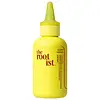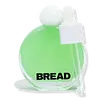What's inside
What's inside
 Key Ingredients
Key Ingredients

 Benefits
Benefits

 Concerns
Concerns

 Ingredients Side-by-side
Ingredients Side-by-side

Aloe Barbadensis Leaf Juice
Skin ConditioningLactobacillus
Skin ConditioningCentella Asiatica Extract
CleansingCoffee Seed Oil PEG-8 Esters
EmollientGanoderma Lucidum Ferment Filtrate
HumectantPanax Ginseng Root
EmollientScutellaria Baicalensis Root Extract
AstringentPisum Sativum Extract
Skin ConditioningAspergillus/Lactobacillus/Rice Seed Extract Ferment Filtrate
EmollientArginine
MaskingGlycolic Acid
BufferingLactic Acid
BufferingWater
Skin ConditioningVinegar
Glycerin
HumectantPolyglyceryl-4 Caprate
EmulsifyingPentylene Glycol
Skin ConditioningHibiscus Sabdariffa Flower Extract
Skin ConditioningInulin
Skin ConditioningGlucomannan
Skin ConditioningAlpha-Glucan Oligosaccharide
CleansingSarcosine
Skin ConditioningMentha Viridis Leaf Oil
AstringentMentha Piperita Oil
MaskingDecyl Glucoside
CleansingSclerotium Gum
Emulsion StabilisingButylene Glycol
HumectantPotassium Hydroxide
BufferingCitric Acid
BufferingPotassium Sorbate
PreservativeSodium Benzoate
Masking1,2-Hexanediol
Skin ConditioningLimonene
PerfumingAloe Barbadensis Leaf Juice, Lactobacillus, Centella Asiatica Extract, Coffee Seed Oil PEG-8 Esters, Ganoderma Lucidum Ferment Filtrate, Panax Ginseng Root, Scutellaria Baicalensis Root Extract, Pisum Sativum Extract, Aspergillus/Lactobacillus/Rice Seed Extract Ferment Filtrate, Arginine, Glycolic Acid, Lactic Acid, Water, Vinegar, Glycerin, Polyglyceryl-4 Caprate, Pentylene Glycol, Hibiscus Sabdariffa Flower Extract, Inulin, Glucomannan, Alpha-Glucan Oligosaccharide, Sarcosine, Mentha Viridis Leaf Oil, Mentha Piperita Oil, Decyl Glucoside, Sclerotium Gum, Butylene Glycol, Potassium Hydroxide, Citric Acid, Potassium Sorbate, Sodium Benzoate, 1,2-Hexanediol, Limonene
Water
Skin ConditioningBrassica Oleracea Italica Sprout Extract
EmollientGluconolactone
Skin ConditioningCoffea Arabica Leaf/Seed Extract
MaskingMelia Azadirachta Leaf Extract
Skin ConditioningMelia Azadirachta Flower Extract
Skin ConditioningSerenoa Serrulata Fruit Extract
Skin ConditioningPrunus Serrulata Flower Extract
Skin ConditioningPalmaria Palmata Extract
Skin ProtectingDavidsonia Jerseyana Fruit Extract
AntioxidantAnanas Sativus Fruit Extract
Skin ConditioningHelianthus Annuus Seed Extract
Skin ConditioningCupressus Sempervirens Leaf/Stem Extract
Skin ConditioningCentella Asiatica Extract
CleansingCamellia Sinensis Leaf Extract
AntimicrobialBackhousia Anisata Leaf Extract
EmollientScutellaria Baicalensis Root Extract
AstringentTriticum Vulgare Germ Extract
Skin ConditioningGlycine Soja Germ Extract
EmollientCoenochloris Signiensis Extract
Skin ConditioningGlycerin
HumectantArginine
MaskingLactic Acid
BufferingTocopherol
AntioxidantHydroxyethylcellulose
Emulsion StabilisingEthylhexylglycerin
Skin ConditioningPropanediol
SolventMandelic Acid
AntimicrobialMaltodextrin
AbsorbentMenthol
MaskingMenthyl Lactate
MaskingSodium Nitrate
SoothingPolysorbate 60
EmulsifyingDisodium Phosphate
BufferingMenthone
PerfumingLimonene
PerfumingL-Menthanone
PerfumingEucalyptol
PerfumingD-Pulegone
PerfumingBeta-Caryophyllene
MaskingNeomenthol
PerfumingSodium Phosphate
BufferingPinene
MaskingSodium Benzoate
MaskingLecithin
EmollientGlyoxal
AntimicrobialCalcium Gluconate
HumectantPhenoxyethanol
PreservativeWater, Brassica Oleracea Italica Sprout Extract, Gluconolactone, Coffea Arabica Leaf/Seed Extract, Melia Azadirachta Leaf Extract, Melia Azadirachta Flower Extract, Serenoa Serrulata Fruit Extract, Prunus Serrulata Flower Extract, Palmaria Palmata Extract, Davidsonia Jerseyana Fruit Extract, Ananas Sativus Fruit Extract, Helianthus Annuus Seed Extract, Cupressus Sempervirens Leaf/Stem Extract, Centella Asiatica Extract, Camellia Sinensis Leaf Extract, Backhousia Anisata Leaf Extract, Scutellaria Baicalensis Root Extract, Triticum Vulgare Germ Extract, Glycine Soja Germ Extract, Coenochloris Signiensis Extract, Glycerin, Arginine, Lactic Acid, Tocopherol, Hydroxyethylcellulose, Ethylhexylglycerin, Propanediol, Mandelic Acid, Maltodextrin, Menthol, Menthyl Lactate, Sodium Nitrate, Polysorbate 60, Disodium Phosphate, Menthone, Limonene, L-Menthanone, Eucalyptol, D-Pulegone, Beta-Caryophyllene, Neomenthol, Sodium Phosphate, Pinene, Sodium Benzoate, Lecithin, Glyoxal, Calcium Gluconate, Phenoxyethanol
Alternatives
Ingredients Explained
These ingredients are found in both products.
Ingredients higher up in an ingredient list are typically present in a larger amount.
Arginine is an amino acid that is important for human development. Your body uses is it to produce hair keratin and skin collagen.
As a cosmetic ingredient, Arginine has antioxidant properties and can also help repair damaged skin. This ingredient is derived either synthetically or from animals.
Arginine isn't fungal acne safe when used in the presence of other lipids (fats, fatty acids, oils, esters, etc). Oils and fats occur naturally within the skin, so take caution when using Arginine if you're prone to fungal acne.
Learn more about ArginineCentella Asiatica Extract (Centella) is derived from an herb native to Southeast Asia. It is famous for its anti-inflammatory and soothing properties.
Centella is rich in antioxidants and amino acids, such as Madecassic Acid and Asiaticoside.
Studies show the compounds in centella help with:
The combination of all these properties makes centella effective at soothing, hydrating, and protecting the skin.
Other great components of centella include Vitamin A, vitamin C, several B vitamins, and Asiatic Acid.
Fun fact: Centella has been used as a medicine and in food for many centuries. As a medicine, it is used to treat burns, scratches, and wounds.
Learn more about Centella Asiatica ExtractGlycerin is already naturally found in your skin. It helps moisturize and protect your skin.
A study from 2016 found glycerin to be more effective as a humectant than AHAs and hyaluronic acid.
As a humectant, it helps the skin stay hydrated by pulling moisture to your skin. The low molecular weight of glycerin allows it to pull moisture into the deeper layers of your skin.
Hydrated skin improves your skin barrier; Your skin barrier helps protect against irritants and bacteria.
Glycerin has also been found to have antimicrobial and antiviral properties. Due to these properties, glycerin is often used in wound and burn treatments.
In cosmetics, glycerin is usually derived from plants such as soybean or palm. However, it can also be sourced from animals, such as tallow or animal fat.
This ingredient is organic, colorless, odorless, and non-toxic.
Glycerin is the name for this ingredient in American English. British English uses Glycerol/Glycerine.
Learn more about GlycerinLactic Acid is another well-loved alpha hydroxy acid (AHA). It is gentler than glycolic acid but still highly effective.
Its main role is to exfoliate the surface of the skin by loosening the “glue” that holds dead skin cells together. Shedding those old cells leads to smoother, softer, and more even-toned skin.
Because lactic acid molecules are larger than glycolic acid, they don’t penetrate as deeply. This means they’re less likely to sting or irritate, making it a great choice for beginners or those with sensitive skin.
Like glycolic acid, it can:
Lactic acid also acts as a humectant (like hyaluronic acid). It can draw water into the skin to improve hydration and also plays a role in the skin's natural moisturizing factor (NMF) in the form of sodium lactate.
Studies show it can boost ceramide production to strengthen the skin barrier and even help balance the skin’s microbiome.
To get results, choose products with a pH between 3-4.
Lower strengths (5-12%) focus on surface exfoliation; higher strengths (12% and up) can reach deeper in the dermis (deeper, supportive layer) to improve skin texture and firmness over time.
Though it was originally derived from milk, most modern lactic acid used in skincare is vegan. It is made through non-dairy fermentation to create a bio-identical and stable form suitable for all formulations.
When lactic acid shows up near the end of an ingredient list, it usually means the brand added just a tiny amount to adjust the product’s pH.
Legend has it that Cleopatra used to bathe in sour milk to help reduce wrinkles.
Lactic acid is truly a gentle multitasker: it exfoliates, hydrates, strengthens, and brightens. It's a great ingredient for giving your skin a smooth, glowing, and healthy look without the harshness of stronger acids.
Read more about some other popular AHA's here:
Learn more about Lactic AcidLimonene is a fragrance that adds scent and taste to a formulation.
It's found in the peel oil of citrus fruits and other plants such as lavender and eucalyptus. The scent of limonene is generally described as "sweet citrus".
Limonene acts as an antioxidant, meaning it helps neutralize free radicals.
When exposed to air, oxidized limonene may sensitize the skin. Because of this, limonene is often avoided by people with sensitive skin.
The term 'fragrance' is not regulated in many countries. In many cases, it is up to the brand to define this term. For instance, many brands choose to label themselves as "fragrance-free" because they are not using synthetic fragrances. However, their products may still contain ingredients such as essential oils that are considered a fragrance.
Learn more about LimoneneScutellaria Baicalensis Root Extract comes from the Baikal skullcap or Chinese skullcap plant. This plant is native to Northeast Asia and can be found in China, Mongolia, Korea, and Siberia.
In cosmetics, Scutellaria Baicalensis Root Extract provides antioxidant and anti-inflammatory benefits. This is due to the flavonoid composition of Scutellaria Baicalensis Root Extract.
In Chinese traditional folk medicine, Scutellaria Baicalensis Root Extract is used to help treat lung issues and hypertension.
Learn more about Scutellaria Baicalensis Root ExtractSodium Benzoate is a preservative. It's used in both cosmetic and food products to inhibit the growth of mold and bacteria. It is typically produced synthetically.
Both the US FDA and EU Health Committee have approved the use of sodium benzoate. In the US, levels of 0.1% (of the total product) are allowed.
Sodium benzoate works as a preservative by inhibiting the growth of bacteria inside of cells. It prevents the cell from fermenting a type of sugar using an enzyme called phosphofructokinase.
It is the salt of benzoic acid. Foods containing sodium benzoate include soda, salad dressings, condiments, fruit juices, wines, and snack foods.
Studies for using ascorbic acid and sodium benzoate in cosmetics are lacking, especially in skincare routines with multiple steps.
We always recommend speaking with a professional, such as a dermatologist, if you have any concerns.
Learn more about Sodium BenzoateWater. It's the most common cosmetic ingredient of all. You'll usually see it at the top of ingredient lists, meaning that it makes up the largest part of the product.
So why is it so popular? Water most often acts as a solvent - this means that it helps dissolve other ingredients into the formulation.
You'll also recognize water as that liquid we all need to stay alive. If you see this, drink a glass of water. Stay hydrated!
Learn more about Water